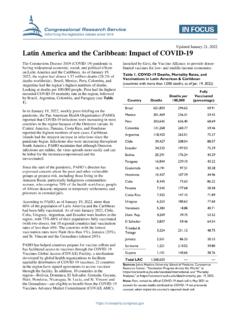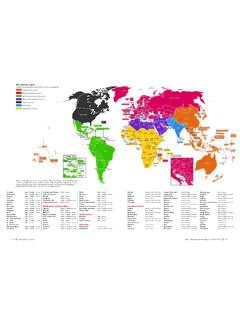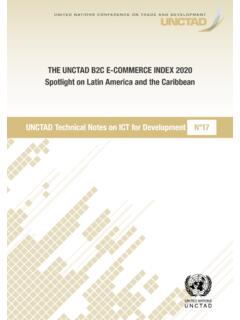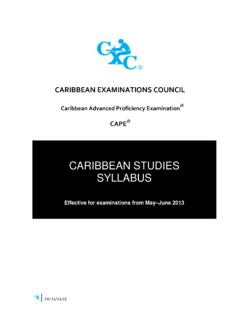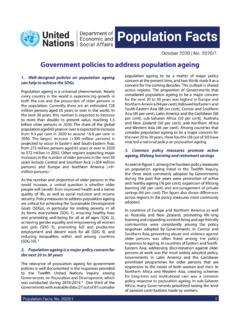Transcription of Current Status of agriculture in the Caribbean and ...
1 2030/ Food, agriculture and rural development in Latin America and the Caribbean Document n 14. Current Status of agriculture in the Caribbean and implications for agriculture policy and strategy 2030/ Food, agriculture and rural development in Latin America and the Caribbean Document n 14. Current Status of agriculture in the Caribbean and implications for agriculture policy and strategy Food and agriculture Organization of the United Nations Santiago, 2019. Required citation: FAO. 2019. Current Status of agriculture in the Caribbean and implications for agriculture Policy and Strategy.
2 2030 - Food, agriculture and rural development in Latin America and the Caribbean , N 14. Santiago de Chile. FAO. 28p Licence: CC BY-NC-SA IGO. The designations employed and the presentation of material in this information product do not imply the expression of any opinion whatsoever on the part of the Food and agriculture Organization of the United Nations (FAO) concerning the legal or development Status of any country, territory, city or area or of its authorities, or concerning the delimitation of its frontiers or boundaries.
3 The mention of specific companies or products of manufacturers, whether or not these have been patented, does not imply that these have been endorsed or recommended by FAO in preference to others of a similar nature that are not mentioned. The views expressed in this information product are those of the author(s) and do not necessarily reflect the views or policies of FAO. FAO, 2019. Some rights reserved. This work is made available under the Creative Commons Attribution-NonCommercial-ShareAlike IGO licence (CC BY-NC-SA IGO; ).
4 Under the terms of this licence, this work may be copied, redistributed and adapted for non-commercial purposes, provided that the work is appropriately cited. In any use of this work, there should be no suggestion that FAO endorses any specific organization, products or services. The use of the FAO logo is not permitted. If the work is adapted, then it must be licensed under the same or equivalent Creative Commons licence. If a translation of this work is created, it must include the following disclaimer along with the required citation: This translation was not created by the Food and agriculture Organization of the United Nations (FAO).
5 FAO is not responsible for the content or accuracy of this translation. The original [English] edition shall be the authoritative edition.. Disputes arising under the licence that cannot be settled amicably will be resolved by mediation and arbitration as described in Article 8 of the licence except as otherwise provided herein. The applicable mediation rules will be the mediation rules of the World Intellectual Property Organization and any arbitration will be conducted in accordance with the Arbitration Rules of the United Nations Commission on International Trade Law (UNCI- TRAL).
6 Third-party materials. Users wishing to reuse material from this work that is attributed to a third party, such as tables, figures or images, are responsible for determining whether permission is needed for that reuse and for obtaining permission from the copyright holder. The risk of claims resulting from infringement of any third-party-owned component in the work rests solely with the user. Sales, rights and licensing. FAO information products are available on the FAO website ( ) and can be purchased through Requests for commercial use should be submitted via: tact-us/licence-request.
7 Queries regarding rights and licensing should be submitted to: Photograph of the cover and back cover: FAO. 1. Introduction The Caribbean region has achieved key development milestones in the post independence era including relatively high human development indices and middle-income Status . Nonetheless, the region continues to face significant socio-economic and climate challenges. These include low and variable economic growth; unsustainable debt and weak fiscal management; high unemployment; high incidence of non-communicable diseases; vulnerability to the effects of climate change and natural hazards; environmental degradation; crime and increasing threats to citizen security; and persistent and extreme poverty and food insecurity most with distinctive gender imbalances.
8 The development of the agriculture sector should be a key priority to address these challenges. However, the region faces major challenges to improve the competitiveness and sustainability of the agriculture sector (including fisheries and aquaculture) and its poverty-reducing capacity. An important factor is the historical difficult structural adjustment of the region's agricultural sector after the end of the preferred EU market access for sugar and bananas. 2030 / Food, agriculture and rural development in Latin America and the Caribbean Growth in agricultural productivity has been slow and the sector suffers from high trade costs and a low capacity to comply with modern food safety and quality standards.
9 As a consequence, it has been unable to adequately respond to rapidly growing demand for high-standard agri- food products from the tourism, processing, and retailing sectors in- and outside the region. Instead, the growing demand by these sectors in the region is mainly fulfilled by imports. The region's agricultural sector is also constrained by large and increasing pressures on natural resources and a high vulnerability to climate change. There is, however, significant potential for strengthening market linkages and much scope for farmers, fishers, and agri-food businesses to catch up with Current best practices and technologies.
10 If the region succeeds in fulfilling this potential without further compromising its natural capital and related ecosystem services, agriculture can be an important source for economic growth and a key contributor to poverty reduction, particularly for households that are profiting less from the growth in other sectors. In addition, inclusive and sustainable agricultural development can contribute in overcoming major socio-economic and environmental challenges in the region, including food and nutrition insecurity, obesity, youth unemployment, gender inequality, unsustainable use of natural resources, and climate change.











